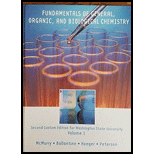
(a)
Interpretation:
Concept Introduction:
Enthalpy
The value of heat formed in a reaction
If the value obtained for
Bond dissociation energy: The energy required for the breaking of a bond between two atoms and separating it into different gas molecules
(b)
Interpretation:
The three ways to increase the production of ammonia has to be determined.
Concept Introduction:
Le Chatelier’s principle:
If an equilibrium is disturbed by changing conditions, the system will moves the equilibrium to reverse the change.
Factor’s that effect chemical equilibria:
- Concentration – Equilibrium will be affected by changing the concentration of reactant or product. If we increase the concentration of reactant system will try to reverse the change by favouring forward reaction and thus increase the concentration of products. Likewise adding products increase yield of reactants.
- Temperature – When the temperature increases equilibrium will shift in the endothermic direction, in the direction that absorbs heat. When the temperature decreases equilibrium will shift in the exothermic direction, in the direction that releases heat.
- Pressure – If the reaction consists of only liquid and solid reactants and products, pressure has no effect in the equilibrium.
In gas reactions if the number of moles has no change then there will be no effect by pressure on equilibrium.
If pressure increases then equilibrium will shift to the direction having less number of molecules and if pressure decreases system will shift to the direction having more number of molecules.
(c)
Interpretation:
The three methods used in Haber-Bosch process to increase the production of ammonia have to be determined.
Concept Introduction:
Le Chatelier’s principle: If an equilibrium is disturbed by changing conditions, the system will moves the equilibrium to reverse the change.
Factor’s that effect chemical equilibria:
- Concentration – Equilibrium will be affected by changing the concentration of reactant or product. If we increase the concentration of reactant system will try to reverse the change by favouring forward reaction and thus increase the concentration of products. Likewise adding products increase yield of reactants.
- Temperature – When the temperature increases equilibrium will shift in the endothermic direction, in the direction that absorbs heat. When the temperature decreases equilibrium will shift in the exothermic direction, in the direction that releases heat.
- Pressure – If the reaction consists of only liquid and solid reactants and products, pressure has no effect in the equilibrium.
In gas reactions if the number of moles has no change then there will be no effect by pressure on equilibrium.
If pressure increases then equilibrium will shift to the direction having less number of molecules and if pressure decreases system will shift to the direction having more number of molecules.
Want to see the full answer?
Check out a sample textbook solution
Chapter 7 Solutions
Fundamentals Of General, Organic, And Biological Chemistry Volume 1 Second Custom Edition For Washington State University, 2/e
- A compound with empirical formula C2H5O was found in a separate experiment to have a molar mass of approximately 90 g. What is the molecular formula of the compound?arrow_forwardHow many grams of glucose (C6H2O6 molecular mass =180daltons) would be present in one liter of a 1M (molar) solution of glucose?arrow_forwardBalance the following equation, and tell how many moles of nickel will reactwith 9.81 mol of hydrochloric acid.arrow_forward
- When Alfred Werner was developing the field of coordination chemistry, it was argued by some that the optical activity he observed in the chiral complexes he had prepared was due to the presence of carbon atoms in themolecule. To disprove this argument, Werner synthesized a chiral complex of cobalt that had no carbon atoms in it, and he was able to resolve it into its enantiomers. Design a cobalt(III) complex that would be chiral if it could be synthesized and that contains no carbon atoms.arrow_forwardConsider the intermolecular forces present in a pure sample of each of the following compounds: CH₃CH₂OH and CH₃COCH₃. Identify the intermolecular forces that these compounds have in common.arrow_forwardIn the Equation: HCO3- + HCl --------> Conjugate Acid + Conjugate Base a ) Which reactant is the Acid? b) Which reactant is the Base? c) What Conjugate Acid will form in this reaction? d) What Conjugate Base will form in this reaction?arrow_forward
- Propanamide and methyl acetate have about the same molar mass, both are quite soluble in water, and yet the boiling point of propanamide is 486 K, whereas that of methyl acetate is 330 K. Explain.arrow_forwardwhat is the conjugate acid for the following reaction? HC2HO4 + H2O <--> H3O+ + C2HO4- A)C2HO4- B) HC2HO4 C)H2O D) H3O+arrow_forwardFor the following reactions, identify the atom(s) being oxidized and reduced:arrow_forward
- Draw condensed structural formulas for the two carboxylic acids with the molecular formula C4H8O2arrow_forwardThreonine has two chiral centers. Draw L-threonine and indicate which carbon atoms are chiral. Which carbon atom is responsible for d and L configuration?arrow_forwardIdentify the conjugate acid-base pairs in the following reactions: HNO2(aq) + H2O(l) → NO2 – (aq) + H3O+(aq) _______ ______ _________ ________ CH3NH2 + H2O(l) → CH3NH3+ + OH – _______ ________ ________ _________arrow_forward
 BiochemistryBiochemistryISBN:9781319114671Author:Lubert Stryer, Jeremy M. Berg, John L. Tymoczko, Gregory J. Gatto Jr.Publisher:W. H. Freeman
BiochemistryBiochemistryISBN:9781319114671Author:Lubert Stryer, Jeremy M. Berg, John L. Tymoczko, Gregory J. Gatto Jr.Publisher:W. H. Freeman Lehninger Principles of BiochemistryBiochemistryISBN:9781464126116Author:David L. Nelson, Michael M. CoxPublisher:W. H. Freeman
Lehninger Principles of BiochemistryBiochemistryISBN:9781464126116Author:David L. Nelson, Michael M. CoxPublisher:W. H. Freeman Fundamentals of Biochemistry: Life at the Molecul...BiochemistryISBN:9781118918401Author:Donald Voet, Judith G. Voet, Charlotte W. PrattPublisher:WILEY
Fundamentals of Biochemistry: Life at the Molecul...BiochemistryISBN:9781118918401Author:Donald Voet, Judith G. Voet, Charlotte W. PrattPublisher:WILEY BiochemistryBiochemistryISBN:9781305961135Author:Mary K. Campbell, Shawn O. Farrell, Owen M. McDougalPublisher:Cengage Learning
BiochemistryBiochemistryISBN:9781305961135Author:Mary K. Campbell, Shawn O. Farrell, Owen M. McDougalPublisher:Cengage Learning BiochemistryBiochemistryISBN:9781305577206Author:Reginald H. Garrett, Charles M. GrishamPublisher:Cengage Learning
BiochemistryBiochemistryISBN:9781305577206Author:Reginald H. Garrett, Charles M. GrishamPublisher:Cengage Learning Fundamentals of General, Organic, and Biological ...BiochemistryISBN:9780134015187Author:John E. McMurry, David S. Ballantine, Carl A. Hoeger, Virginia E. PetersonPublisher:PEARSON
Fundamentals of General, Organic, and Biological ...BiochemistryISBN:9780134015187Author:John E. McMurry, David S. Ballantine, Carl A. Hoeger, Virginia E. PetersonPublisher:PEARSON





